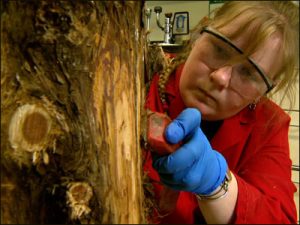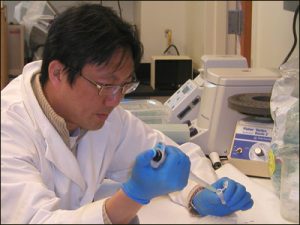
COLUMBIA, Mo.- Chung-Ho Lin, research assistant professor with the MU Center for Agroforestry, has found that red cedar leaves and fruit have compounds that might help fight bacteria, fungi, agricultural pests and weeds, and malaria.
It might also prevent skin cancer by inhibiting the production of melanin.
Lin and students Mark Hymbaugh, MU senior in biochemistry, and Amber Spohn, senior in environmental geology, studied the fruit, leaves, branches, roots, sawdust, oil, resin and bark of the red cedar, to determine which parts might have beneficial compounds.
Chemical compounds found in the leaves and fruit had the most promising results, although levels of activity varied. The potent compounds in the extracts showing high bioactivities will be further isolated and purified for chemical characterization.
“Every chemical has a ‘fingerprint,'” Lin said. “We use the fingerprint of the unknown compound and compare it to known chemical fingerprints in an existing database.”
At least two antibacterial chemicals in the red cedar needles (leaves) have been isolated. These chemicals are similar to others found in past studies that have proven effective against a wide range of bacteria.

Other chemicals have shown promising inhibitory effects on melanin development and tyrosinase activity. This means they have great potential for preventing and healing pigmentation in sunburn, freckles and liver spots.
Best of all, this class of chemicals has been proven to be very safe for external skin application.
The research also focuses on assessing the application of these chemicals in the agricultural, pharmaceutical and cosmetic industries.
“Value-added phytochemical products from eastern red cedar have the potential to create new industries in regions with an abundant red cedar resource,” Lin said.
Mike Gold, associate director of the MU Center for Agroforestry, said the goal of the Center is to help landowners around the country get the most from their land.
“The question is how can we take what you might call lemons and make lemonade,” Gold said. “Since we’ve got this abundant resource, not just for the wood, we now can take something that was a problem and hopefully turn it into a very lucrative industry.”